Abstract
Complex antagonistic interactions between abscisic acid (ABA) and brassinosteroid (BR) signalling pathways have been widely documented. However, whether or how ABA interacts synergistically with BR in plants remains to be elucidated. Here, we report that low, but not high, concentration of ABA increases lamina joint inclination of rice seedling, which requires functional BR biosynthesis and signalling. Transcriptome analyses confirm that about 60% of low-concentration ABA early response genes can be regulated by BR in the same directions. ABA activates BR signal in a fast, limited and short-term manner and the BR-biosynthesis regulatory gene, OsGSR1, plays a key role during this process, whose expression is induced slightly by ABA through transcriptional factor ABI3. Moreover, the early short-term BR signal activation is also important for ABA-mediated salt stress tolerance. Intriguingly, the process and effect of short-term BR signal activation were covered by high concentration of ABA, implying adaptive mechanisms existed in plants to cope with varying degrees of stress.
This is a preview of subscription content, access via your institution
Access options
Access Nature and 54 other Nature Portfolio journals
Get Nature+, our best-value online-access subscription
$29.99 / 30 days
cancel any time
Subscribe to this journal
Receive 12 digital issues and online access to articles
$119.00 per year
only $9.92 per issue
Buy this article
- Purchase on Springer Link
- Instant access to full article PDF
Prices may be subject to local taxes which are calculated during checkout







Similar content being viewed by others
Data availability
Genome sequence data from this study can be found in the GenBank/EMBL libraries under the following accession numbers: Os01g0911700 (ABI3), Os01g0859300 (ABI5), Os04g0448900 (ABA1), Os01g0197100 (D2), Os04g0469800 (D11), Os06g0266800 (OsGSR1) and Os07g0569100 (OsREM4.1). O. sativa proteome sequences were downloaded from IRGSP (http://rice.plantbiology.msu.edu/). The RNA-seq data have been deposited in Sequence Read Archive of NCBI (https://trace.ncbi.nlm.nih.gov/Traces/sra/sra.cgi?) under accession number PRJNA732471. The data supporting the findings of this study are available within the article and its supplementary data, or from the corresponding authors upon reasonable request. Source data are provided with this paper.
References
Zhao, Y. et al. The unique mode of action of a divergent member of the ABA-receptor protein family in ABA and stress signaling. Cell Res. 23, 1380–1395 (2013).
Ma, Y. et al. Regulators of PP2C phosphatase activity function as abscisic acid sensors. Science 324, 1064–1068 (2009).
Park, S. Y. et al. Abscisic acid inhibits type 2C protein phosphatases via the PYR/PYL family of START proteins. Science 324, 1068–1071 (2009).
Fuchs, S., Tischer, S. V., Wunschel, C., Christmann, A. & Grill, E. Abscisic acid sensor RCAR7/PYL13, specific regulator of protein phosphatase coreceptors. Proc. Natl Acad. Sci. USA 111, 5741–5746 (2014).
Leung, J. et al. Arabidopsis ABA response gene ABI1: features of a calcium-modulated protein phosphatase. Science 264, 1448–1452 (1994).
Fujii, H. et al. In vitro reconstitution of an abscisic acid signalling pathway. Nature 462, 660–664 (2009).
Nishimura, N. et al. PYR/PYL/RCAR family members are major in-vivo ABI1 protein phosphatase 2C-interacting proteins in Arabidopsis. Plant J. 61, 290–299 (2010).
Furihata, T. et al. Abscisic acid-dependent multisite phosphorylation regulates the activity of a transcription activator AREB1. Proc. Natl Acad. Sci. USA 103, 1988–1993 (2006).
Santiago, J. et al. The abscisic acid receptor PYR1 in complex with abscisic acid. Nature 462, 665–668 (2009).
Parcy, F., Valon, C., Kohara, A., Misera, S. & Giraudat, J. The ABSCISIC ACID-INSENSITIVE3, FUSCA3, and LEAFY COTYLEDON1 loci act in concert to control multiple aspects of Arabidopsis seed development. Plant Cell 9, 1265–1277 (1997).
Nambara, E. et al. The role of ABI3 and FUS3 loci in Arabidopsis thaliana on phase transition from late embryo development to germination. Dev. Biol. 220, 412–423 (2000).
Finkelstein, R. R. & Lynch, T. J. The Arabidopsis abscisic acid response gene ABI5 encodes a basic leucine zipper transcription factor. Plant Cell 12, 599–609 (2000).
Lopez-Molina, L., Mongrand, S., McLachlin, D. T., Chait, B. T. & Chua, N. H. ABI5 acts downstream of ABI3 to execute an ABA-dependent growth arrest during germination. Plant J. 32, 317–328 (2002).
Nakamura, S., Lynch, T. J. & Finkelstein, R. R. Physical interactions between ABA response loci of Arabidopsis. Plant J. 26, 627–635 (2001).
Kinoshita, T. et al. Binding of brassinosteroids to the extracellular domain of plant receptor kinase BRI1. Nature 433, 167–171 (2005).
Wang, X. et al. Sequential transphosphorylation of the BRI1/BAK1 receptor kinase complex impacts early events in brassinosteroid signaling. Dev. Cell 15, 220–235 (2008).
Russinova, E. et al. Heterodimerization and endocytosis of Arabidopsis brassinosteroid receptors BRI1 and AtSERK3 (BAK1). Plant Cell 16, 3216–3229 (2004).
Tang, W. et al. BSKs mediate signal transduction from the receptor kinase BRI1 in Arabidopsis. Science 321, 557–560 (2008).
Kim, T. W. et al. Brassinosteroid signal transduction from cell-surface receptor kinases to nuclear transcription factors. Nat. Cell Biol. 11, 1254–1260 (2009).
Li, J. & Nam, K. H. Regulation of brassinosteroid signaling by a GSK3/SHAGGY-like kinase. Science 295, 1299–1301 (2002).
Wang, Z. Y. et al. Nuclear-localized BZR1 mediates brassinosteroid-induced growth and feedback suppression of brassinosteroid biosynthesis. Dev. Cell 2, 505–513 (2002).
Yin, Y. et al. A new class of transcription factors mediates brassinosteroid-regulated gene expression in Arabidopsis. Cell 120, 249–259 (2005).
He, J. X. et al. BZR1 is a transcriptional repressor with dual roles in brassinosteroid homeostasis and growth responses. Science 307, 1634–1638 (2005).
Steber, C. M. & McCourt, P. A role for brassinosteroids in germination in Arabidopsis. Plant Physiol. 125, 763–769 (2001).
Zhang, S., Cai, Z. & Wang, X. The primary signaling outputs of brassinosteroids are regulated by abscisic acid signaling. Proc. Natl Acad. Sci. USA 106, 4543–4548 (2009).
Nemhauser, J. L., Hong, F. X. & Chory, J. Different plant hormones regulate similar processes through largely nonoverlapping transcriptional responses. Cell 126, 467–475 (2006).
Northey, J. G. et al. Farnesylation mediates brassinosteroid biosynthesis to regulate abscisic acid responses. Nat. Plants 2, 16114 (2016).
Cai, Z. et al. GSK3-like kinases positively modulate abscisic acid signaling through phosphorylating subgroup III SnRK2s in Arabidopsis. Proc. Natl Acad. Sci. USA 111, 9651–9656 (2014).
Hu, Y. & Yu, D. BRASSINOSTEROID INSENSITIVE2 interacts with ABSCISIC ACID INSENSITIVE5 to mediate the antagonism of brassinosteroids to abscisic acid during seed germination in Arabidopsis. Plant Cell 26, 4394–4408 (2014).
Zhao, X., Dou, L., Gong, Z., Wang, X. & Mao, T. BES1 hinders ABSCISIC ACID INSENSITIVE5 and promotes seed germination in Arabidopsis. New Phytol. 221, 908–918 (2018).
Ryu, H., Cho, H., Bae, W. & Hwang, I. Control of early seedling development by BES1/TPL/HDA19-mediated epigenetic regulation of ABI3. Nat. Commun. 5, 4138 (2014).
Wang, H. et al. Abscisic acid signaling inhibits brassinosteroid signaling through dampening the dephosphorylation of BIN2 by ABI1 and ABI2. Mol. Plant 11, 315–325 (2018).
Gui, J. et al. OsREM4.1 interacts with OsSERK1 to coordinate the interlinking between abscisic acid and brassinosteroid signaling in rice. Dev. Cell 38, 201–213 (2016).
Zhou, J. et al. H2O2 mediates the crosstalk of brassinosteroid and abscisic acid in tomato responses to heat and oxidative stresses. J. Exp. Bot. 65, 4371–4383 (2014).
Zhang, A. et al. Nitric oxide mediates brassinosteroid-induced ABA biosynthesis involved in oxidative stress tolerance in maize leaves. Plant Cell Physiol. 52, 181–192 (2011).
Tong, H. & Chu, C. Functional specificities of brassinosteroid and potential utilization for crop improvement. Trends Plant Sci. 23, 1016–1028 (2018).
Kim, H. et al. A rice orthologue of the ABA receptor, OsPYL/RCAR5, is a positive regulator of the ABA signal transduction pathway in seed germination and early seedling growth. J. Exp. Bot. 63, 1013–1024 (2012).
Wang, L. et al. OsGSR1 is involved in crosstalk between gibberellins and brassinosteroids in rice. Plant J. 57, 498–510 (2009).
Shimada, A. et al. The rice SPINDLY gene functions as a negative regulator of gibberellin signaling by controlling the suppressive function of the DELLA protein, SLR1, and modulating brassinosteroid synthesis. Plant J. 48, 390–402 (2006).
Tong, H. et al. Brassinosteroid regulates cell elongation by modulating gibberellin metabolism in rice. Plant Cell 26, 4376–4393 (2014).
Zhang, S. N. et al. The auxin response factor, OsARF19, controls rice leaf angles through positively regulating OsGH3-5 and OsBRI1. Plant Cell Environ. 38, 638–654 (2015).
Song, Y., You, J. & Xiong, L. Characterization of OsIAA1 gene, a member of rice Aux/IAA family involved in auxin and brassinosteroid hormone responses and plant morphogenesis. Plant Mol. Biol. 70, 297–309 (2009).
Gan, L. et al. Methyl jasmonate inhibits lamina joint inclination by repressing brassinosteroid biosynthesis and signaling in rice. Plant Sci. 241, 238–245 (2015).
Cao, H. P. & Chen, S. K. Brassinosteroid-induced rice lamina joint inclination and its relation to indole-3-acetic-acid and ethylene. Plant Growth Regul. 16, 189–196 (1995).
Zhao, S. Q., Xiang, J. J. & Xue, H. W. Studies on the rice LEAF INCLINATION1 (LC1), an IAA-amido synthetase, reveal the effects of auxin in leaf inclination control. Mol. Plant 6, 174–187 (2013).
Bai, M. Y. et al. Functions of OsBZR1 and 14-3-3 proteins in brassinosteroid signaling in rice. Proc. Natl Acad. Sci. USA 104, 13839–13844 (2007).
Yamamuro, C. et al. Loss of function of a rice brassinosteroid insensitive1 homolog prevents internode elongation and bending of the lamina joint. Plant Cell 12, 1591–1606 (2000).
Tong, H. N. et al. DWARF AND LOW-TILLERING acts as a direct downstream target of a GSK3/SHAGGY-like kinase to mediate brassinosteroid responses in rice. Plant Cell 24, 2562–2577 (2012).
Hong, Z. et al. A rice brassinosteroid-deficient mutant, ebisu dwarf (d2), is caused by a loss of function of a new member of cytochrome P450. Plant Cell 15, 2900–2910 (2003).
Tanabe, S. et al. A novel cytochrome P450 is implicated in brassinosteroid biosynthesis via the characterization of a rice dwarf mutant, dwarf11, with reduced seed length. Plant Cell 17, 776–790 (2005).
Saika, H. et al. Ethylene promotes submergence-induced expression of OsABA8ox1, a gene that encodes ABA 8′-hydroxylase in rice. Plant Cell Physiol. 48, 287–298 (2007).
Zhu, G. H., Ye, N. H. & Zhang, J. H. Glucose-induced delay of seed germination in rice is mediated by the suppression of ABA catabolism rather than an enhancement of ABA biosynthesis. Plant Cell Physiol. 50, 644–651 (2009).
Li, C. X., Shen, H. Y., Wang, T. & Wang, X. L. ABA regulates subcellular redistribution of OsABI-LIKE2, a negative regulator in ABA signaling, to control root architecture and drought resistance in Oryza sativa. Plant Cell Physiol. 56, 2396–2408 (2015).
Xiang, Y., Tang, N., Du, H., Ye, H. Y. & Xiong, L. Z. Characterization of OsbZIP23 as a key player of the basic leucine zipper transcription factor family for conferring abscisic acid sensitivity and salinity and drought tolerance in rice. Plant Physiol. 148, 1938–1952 (2008).
Liu, J. M. et al. Loose Plant Architecture1 (LPA1) determines lamina joint bending by suppressing auxin signalling that interacts with C-22-hydroxylated and 6-deoxo brassinosteroids in rice. J. Exp. Bot. 67, 1883–1895 (2016).
Zhang, G. et al. A small G protein as a novel component of the rice brassinosteroid signal transduction. Mol. Plant 9, 1260–1271 (2016).
Xiao, Y. H., Liu, D. P., Zhang, G. X., Tong, H. N. & Chu, C. C. Brassinosteroids regulate OFP1, a DLT interacting protein, to modulate plant architecture and grain morphology in rice. Front. Plant Sci. 8, 1698 (2017).
Ruan, W. Y. et al. An SPX-RLI1 module regulates leaf inclination in response to phosphate availability in rice. Plant Cell 30, 853–870 (2018).
Aya, K. et al. A novel AP2-type transcription factor, SMALL ORGAN SIZE1, controls organ size downstream of an auxin signaling pathway. Plant Cell Physiol. 55, 897–912 (2014).
Chen, Q. L. et al. Characterization of Rolled and Erect Leaf 1 in regulating leave morphology in rice. J. Exp. Bot. 66, 6047–6058 (2015).
Agrawal, G. K. et al. Screening of the rice viviparous mutants generated by endogenous retrotransposon Tos17 insertion. Tagging of a zeaxanthin epoxidase gene and a novel ostatc gene. Plant Physiol. 125, 1248–1257 (2001).
Kim, T.-W. et al. OST1 activation by the brassinosteroid-regulated kinase CDG1-LIKE1 in stomatal closure. Plant Cell 30, 1848–1863 (2018).
Kim, T.-W. et al. RETRACTION: OST1 activation by the brassinosteroid-regulated kinase CDG1-LIKE1 in stomatal closure. Plant Cell 32, 286 (2019).
Li, Q. F. et al. Abscisic acid represses rice lamina joint inclination by antagonizing brassinosteroid biosynthesis and signaling. Int. J. Mol. Sci. 20, 4908 (2019).
Tang, J. et al. Mutation of a nucleotide-binding leucine-rich repeat immune receptor-type protein disrupts immunity to bacterial blight. Plant Physiol. 181, 1295–1313 (2019).
Kim, D., Paggi, J. M., Park, C., Bennett, C. & Salzberg, S. L. Graph-based genome alignment and genotyping with HISAT2 and HISAT-genotype. Nat. Biotechnol. 37, 907–915 (2019).
Love, M. I., Huber, W. & Anders, S. Moderated estimation of fold change and dispersion for RNA-seq data with DESeq2. Genome Biol. 15, 550 (2014).
Li, J. et al. Modulation of BIN2 kinase activity by HY5 controls hypocotyl elongation in the light. Nat. Commun. 11, 1592 (2020).
Yoo, S. D., Cho, Y. H. & Sheen, J. Arabidopsis mesophyll protoplasts: a versatile cell system for transient gene expression analysis. Nat. Protoc. 2, 1565–1572 (2007).
Tang, Q. Y. & Zhang, C. X. Data Processing System (DPS) software with experimental design, statistical analysis and data mining developed for use in entomological research. Insect Sci. 20, 254–260 (2013).
Acknowledgements
We thank J. Fang, H. Tong and Y. Xiao for providing the seeds of ABA and BR-related mutants. We also thank G. Li for performing field cultivation and S. Cao for performing rice transformation. This work was supported by the National Natural Science Foundation of China (grant nos. 31771360 and 32070547).
Author information
Authors and Affiliations
Contributions
J.T. and C.C. conceived the project, designed the experiments and analysed the data. Q.L. and J.T. performed most of the experiments with the help of F.X., Z.C., K.S., Y.L., Z.T, J.Y., G.Z., X.L., X.H., L.D., Y.Q. and Y.W. J.T. wrote the manuscript. C.C. and Q.L. revised the manuscript with contributions from all authors.
Corresponding authors
Ethics declarations
Competing interests
The authors declare no competing interests.
Additional information
Peer review information Nature Plants thanks Qiaoquan Liu, Brigitte Poppenberger and Hojin Ryu for their contribution to the peer review of this work.
Publisher’s note Springer Nature remains neutral with regard to jurisdictional claims in published maps and institutional affiliations.
Supplementary information
Supplementary Information
Supplementary Figs. 1–10.
Supplementary Table 1
The genes regulated by ABA or BL at each time point (log2 ≥ 0.5 or ≤ –0.5 and Padj ≤ 0.05). A, ABA treatment; B, BL treatement. 0.5, 1, 2 and 4 indicate 0.5, 1, 2 and 4 hours after ABA or BL treatments, respectively.
Supplementary Table 2
Genome-wide transcription profiles of gsr1-1, abi3 and dlt. log2 ≥ 0.5 or ≤ −0.5 and Padj ≤ 0.01.
Supplementary Table 3
Primer pairs used in this study.
Source data
Source Data Fig. 2
Original western blots.
Source Data Fig. 5
Original EMSA PAGE.
Rights and permissions
About this article
Cite this article
Li, Q., Xu, F., Chen, Z. et al. Synergistic interplay of ABA and BR signal in regulating plant growth and adaptation. Nat. Plants 7, 1108–1118 (2021). https://doi.org/10.1038/s41477-021-00959-1
Received:
Accepted:
Published:
Issue Date:
DOI: https://doi.org/10.1038/s41477-021-00959-1
This article is cited by
-
The study on interacting factors and functions of GASA6 in Jatropha curcas L.
BMC Plant Biology (2023)
-
Genome-wide identification and expression analysis of BZR gene family and associated responses to abiotic stresses in cucumber (Cucumis sativus L.)
BMC Plant Biology (2023)
-
Comparative transcriptome analysis reveals the function of SlPRE2 in multiple phytohormones biosynthesis, signal transduction and stomatal development in tomato
Plant Cell Reports (2023)
-
Transcriptomic analysis provides insights into the abscisic acid mediates brassinosteroid-induced cold resistance of grapevine (Vitis vinifera L.)
Plant Growth Regulation (2023)
-
Antagonistic control of seed dormancy in rice by two bHLH transcription factors
Nature Genetics (2022)



